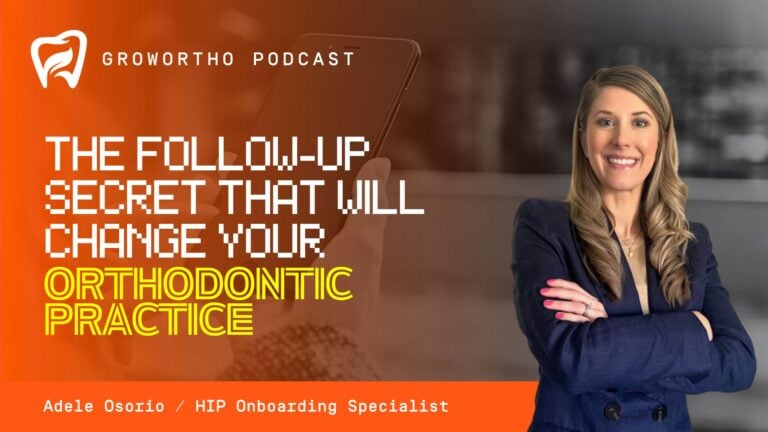Most practices try to buy growth with more marketing. That works until it doesn’t. If your systems leak, more demand just leaks faster. The sustainable path is a simple trifecta that turns attention into starts: marketing to create demand, tracking technology to see what’s happening, and coaching to improve what people do next. When you integrate all three, you get compounding gains. When you run only one, you burn money and morale.
HIP’s position is clear. Marketing alone won’t solve your problems. You need a framework that’s built back to front, tied to leadership, roles, and a repeatable way of working. That means demand generation plus software that tracks both marketing and team actions, inside a tool your team actually uses, with ongoing mentoring and training to raise the bar week after week.
Why One Leg Fails
A vendor can send leads. If nobody answers quickly, follows up well, or asks for the next step, the outcome is the same as no leads. That’s why we refuse to be just a “deliverables” partner. The job is to integrate with operations and make the whole system better so the practice converts more of what it already earns.
The other reason “marketing only” stalls is a talent and training gap. Many practices assign the highest-value moments to the least-trained person, then judge the channel by the result. That’s not a tech issue. It’s a skills issue. Even a front desk or scheduling coordinator needs two solid days of role-play and scripting to be ready for real conversations, yet very few teams ever do that.
The Trifecta, Explained
Marketing — Create Consistent, Scalable Demand
Referrals matter, but they’re not enough if you want predictable growth. The driver in orthodontics today is adults, and adults aren’t living in your traditional referral loops. If you want exponential, predictable growth, the internet is the best way to reach and nurture this audience. Build offers, content, and funnels that respect how adults research and buy.
Tracking Technology — See Reality and Create Accountability
Your platform should do three jobs:
- Attribute demand across channels and campaigns.
- Track team actions on every lead and patient touch inside one shared workspace.
- Create accountability with simple dashboards so leaders can coach what’s real, not what they hope is happening.
The point is practical. If you can’t see it, you can’t improve it. You need evidence of time to first touch, number of attempts, talk time, consult set, consult kept, and start. We build technology to track marketing and team actions in one place so the right people get coached on the right moments.
Coaching — Upgrade Conversations, Not Just Tools
Tools don’t close patients. People do. Your team needs coaching on tone, pacing, objection handling, and handoffs. They also need a mindset shift. Internet leads aren’t bad. They’re distracted and short on attention. With the right response and persistence, they convert. Small changes in how you engage can produce three times to twenty-one times gains. That’s the upside of coaching around the exact words, questions, and requests you make.
Build Back to Front
Most doctors were trained for clinical excellence, not organizational design. Growth requires the opposite sequence. Start with leadership, roles, and operating rhythm. Then layer in marketing, software, and coaching. Ask basic questions. Do you run one-on-ones? Do you have a clear org chart and owners for first response, reactivation, and after-hours coverage? Flattened organizations stall because nobody is truly accountable for outcomes that matter.
Install the System — A 90-Day Playbook
Days 1–30: See It Clearly
- Define the scoreboard. Track time to first touch, attempts per lead, connect rate, consult set, consult kept, and starts by source. Put it where the team can see it.
- Write coverage rules. Lunch, late afternoon, Fridays, and after-hours. Name the owners. No dead ends.
- Install one-minute SLA. The first dial within 60 seconds for web leads. Why the urgency? Because calling within one minute lifts contact and qualification odds by 391 percent and the odds fall 400 percent after five minutes. Build that into your tools.
Days 31–60: Make the Tech Do the Work
- Automate the cadence. Create a six-touch sequence blending calls and texts inside your CRM. The research says six attempts. Set it and make it easy to run.
- Dial-first workflow. Text is convenient, but 92 percent of interactions still happen by phone. Trigger a call task first, then follow with a short text that confirms the next step.
- Attribution and alerts. Route hot leads to trained closers. Trigger alerts for any lead that hasn’t been touched within five minutes.
Days 61–90: Coach What Matters
- Two training days minimum for schedulers and treatment coordinators. Role-play the open, the ask, and the close. Repeat it until it’s smooth.
- Weekly call reviews. Ten calls per rep, scored on speed, clarity, empathy, and a direct request for the next step.
- Scenario libraries. Save great calls on price shoppers, “we’re just looking,” insurance, and rescheduling. Use them as the standard.
What Success Looks Like
When the trifecta is working, leaders see a flywheel:
- Marketing generates steady adult demand online with offers that earn attention.
- Tracking tech shows where momentum stalls so you can intervene in real time.
- Coaching tightens language, reduces variability, and compounds the conversion lift. Change the way you engage and you can triple or quintuple results.
A second-order benefit is cultural. The team stops saying “the leads are bad” and starts asking “how do we help faster and ask better.” That shift unlocks persistence. We see practices contact high-intent leads a dozen times, politely, over seven to ten days, and win starts they would have labeled “no response” a year ago. The data and a quick personal case study prove the point: persistence over a dozen touches converted a lead that initially didn’t remember the contact.
Avoid These Common Failure Modes
- Deliverables without integration. A list of tasks and assets won’t move the needle unless they map to your workflows and coverage. We integrate with operations so demand flows to starts.
- No accountable owner. If everyone owns speed to lead, nobody owns speed to lead. Assign it. Measure it. Coach it.
- Undertrained frontline. The practice entrusts the most critical revenue moments to someone who isn’t trained in consultative selling and earns minimal wage. That’s an expensive “savings.” Upgrade the role and coach it.
- Short-term thinking. Adults can take months to move. Treat the internet like a long game with consistent nurture rather than a one-call close mindset.
A Simple Operating Rhythm
- Daily: Team huddle on yesterday’s scoreboard. Celebrate the fastest qualified response and the cleanest handoff.
- Weekly: Call reviews, one improvement target, one script update.
- Monthly: Offer refresh and landing page tune-ups, channel allocation review, and skills workshop on a single objection.
- Quarterly: Rebuild the pipeline rules. Update coverage. Reset goals tied to starts and profit, not impressions.
Bring It Together
Growth is a system. Marketing creates demand. Tracking tech tells the truth. Coaching raises performance. Tie them together and you stop guessing. You see exactly where momentum dies and you fix it. You set a one-minute standard because that’s what consumers reward. You hold six-touch follow-up because that’s what the research supports. You coach the open, the ask, and the handoff because small changes in language drive outsized results.
Most important, you build it back to front so leadership, roles, and culture carry the system when things get busy. That’s how you turn last month’s spikes into next quarter’s baseline. That’s how you move from “more leads, please” to “more starts, predictably.” And that’s how you grow with integrity, serving more patients and building a practice that works as hard for you as you do for it.


